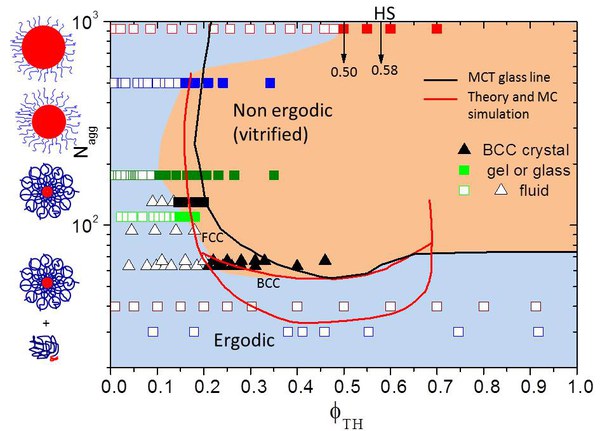Soft colloids and gels
Recent studies on soft matter include a large variety of complex fluids such as synthetic polymers, biological macromolecules, colloids, amphiphilic systems, membranes as well as liquid crystals. A current active field of research is focused on the special class of soft colloids, i.e. elastic and deformable colloidal particles, with a dual character somewhere between polymers and hard spheres. Examples of such soft colloids are vesicles, dendrimers, microgels, polymer-grafted nanoparticles, block copolymer micelles and star polymers.
Hybrids between Polymers and Colloids
Due to their hybrid nature, soft colloids macroscopically show interesting structural as well as flow and mechanical properties resulting from their unique microscopic structure. The combination of polymer-like properties, i.e. the formation of (transient) geometric constraints due to overlapping polymeric coronas and direct colloidal interactions due to their (hard) core, in particular affects flow properties and the non-equilibrium behaviour of soft colloids.
Therefore soft colloids are frequently used in many technical applications (paints, shampoos, motor oils, polymer nano-composites etc.). The challenge of fundamental research on soft colloids is to investigate the basic principles that allow the tailoring of material properties for technical applications. However, for such comprehensive studies, excellent model systems are an important prerequisite.

Molecular Architecture & Exchange Kinetics
We established micelles formed by amphiphilic block copolymers as a tunable model system for soft colloids. Precise control of softness is based on several pillars: i) carefully chosen types of monomers and selective solvent, ii.) well-defined molecular parameters block ratio, molecular weight, and polydispersity guaranteed by use of anionic polymerisation and, iii.) precise understanding and control of micellar exchange kinetics.
Somit können Block-Kopolymer basierte weiche Kolloide ihre “Weichheit” an externe Parameter anpassen, solange ein Austausch nicht vollständig eingefroren ist.

In contrast to conventional soft colloids like star polymers or microgels, block copolymer micelles are “living” systems, since they are not covalently linked. Hence, block copolymer based soft colloids can adjust its softness to external parameters, unless chain exchange is completely frozen.
Finally, colloids with well-defined softness are formed by self-assembly. Theoretically, softness is described by only two parameters, the functionality f which is the number of polymer arms emanating from the central core and the interaction length s. For block copolymer micelles this directly transforms into the micellar aggregation number Nagg, i.e. number of block copolymers within a single micelle, and micellar radius, both unambiguously given by experiment.
(Phys. Rev. Letters 94 195504 2005; Phys. Rev. Letters 104 049902 2010; Softmatter 11 4208 2015)
Interactions, Structure & Phase Behaviour
The macroscopic softness of soft colloids results from two microscopic contributions i) the deformability of the individual colloidal particle, its intramolecular softness, and ii) the form of particle interactions in terms of an effective potential (its intermolecular softness). Small Angle Neutron Scattering (SANS) combined with contrast variation is an excellent tool to investigate the structure and interaction of soft colloids on a microscopic level. Based on SANS experiments we interpret rheological and dynamic light scattering (DLS) data in terms of recently developed experimental and theoretical approaches that quantitatively describe microscopic structure. This finally enabled us to derive the dynamic phase diagram of soft colloids showing convincing agreement between experiment and theory without any adjustable parameter.

(Phys. Rev. E 76 041503 2007; Phys. Rev. Lett.106 228301 2011; Nanoscale 7 13924 2015)
Flow Behaviour and Rheology
The effect of external shear on the structure of soft colloids was investigated in situ by Small Angle Neutron Scattering, Rheo-SANS, within the framework of the Transregional Collaborative Research Centre SFB TR 6 Physics of Colloidal Dispersions in External Fields, subproject A2 ”Tunable Model Systems for Soft Colloids”.

Shear induced crystallization followed by shear induced melting in concentrated solutions of soft colloids was observed using Rheo-SANS. Furthermore, we were able to understand the connection between structure and flow by means of the advanced rheological characterization of our soft colloidal model system.
(Journal of Rheology 54 1219 2010; J. Phys.: Condens. Matter 24 464102 2012; Eur. Phys. J. Special Topics 222 2757–2772 2013)
Meso- and Microscopic Dynamics
Based on the structural properties of soft colloids we investigated the dynamics of kinetically frozen block copolymer micelles of different softness across a wide range of particle concentrations, from the fluid to the onset of glassy behavior, through a combination of rheology, dynamic light scattering and pulsed field gradient NMR spectroscopy.

We additionally performed Brownian dynamics simulations based on an ultra-soft coarse-grained potential, which are found to be in quantitative agreement with experiments, capturing even the very details of dynamic structure factors S(Q; t) on approaching the glass transition. We provide evidence that for these systems the Stokes-Einstein relation holds up to the glass transition; given that it is violated for dense suspensions of hard colloids, our findings suggest that its validity is an intriguing signature of ultra-soft interactions.
(Phys. Rev. Letters 115 128302 2015)
Anwendungen weicher Kolloide
Another type of soft colloids, namely microgels, are used as carriers for catalysts within the Collaborative Research Centre SFB 985 "Functional Microgels and Microgel Systems“, subproject A2 "Microgel supported catalysts for olefin polymerization”.

We will systematically investigate how the supramolecular microgel structure influences the reaction profile of an active olefin polymerization catalyst. New microgel supported metallocene and non-metallocene catalysts will be developed with the following aims: i.) olefin polymerization in aqueous environments via amphiphilic core-shell microgels, ii.) stereoselective polymerization without chiral ligands via chiral microgels, and iii.) improved mechanical properties of the polyolefin via subsequent use of microgel supports as intrinsic nanofillers.
